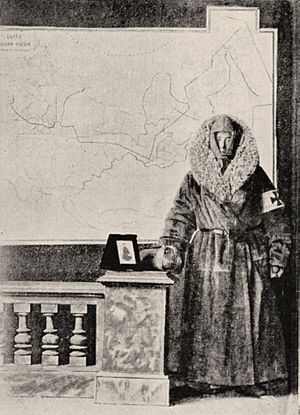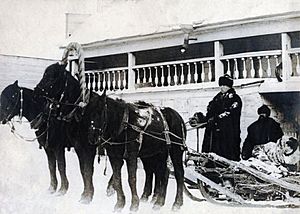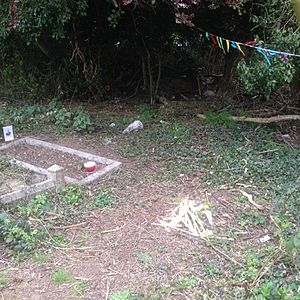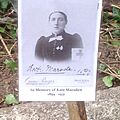Kate Marsden facts for kids
Quick facts for kids
Kate Marsden
|
|
|---|---|
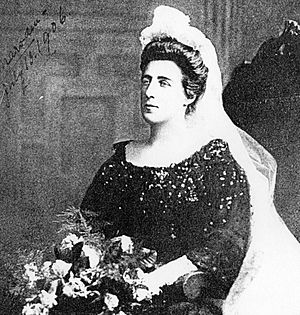 |
|
| Born | 13 May 1859 Edmonton, London
|
| Died | 26 May 1931 (aged 72) London
|
| Known for | Travelling to Siberia to find a leprosy cure |
| Signature | |
Kate Marsden (born May 13, 1859 – died May 26, 1931) was a brave British nurse, explorer, and writer. She was also a missionary, meaning she traveled to share her beliefs and help others. Kate Marsden is famous for her long journey to Siberia to find a cure for leprosy, a serious skin disease.
She had support from important people like Queen Victoria of England and Empress Maria Feodorovna of Russia. Kate traveled all the way from Moscow to Siberia and back. During her trip, she set up a special center to help people with leprosy. When she returned to England, she helped start the Bexhill Museum. Kate Marsden was also chosen as a member of the Royal Geographical Society, a group for explorers and geographers. There's even a large diamond named after her! People in Siberia still remember her, and a big statue was built in her honor in 2014.
Contents
Early Life and Nursing Career
Kate Marsden was born in Edmonton, London, in 1859. Her father was a lawyer, and her uncle, Captain James Raymond Wellsted, was a famous explorer.
When she was just 16, Kate became a nurse and started working in a London hospital. Later, she moved to New Zealand with her mother to care for her sick sister. Her sister sadly passed away soon after they arrived. Kate became a head nurse at Wellington Hospital in New Zealand. She worked there for five months before she had an accident and had to stop working for a while.
Kate also started a St John Ambulance group in New Zealand. She gave talks and announced her plan to travel to Europe to meet Louis Pasteur, a famous scientist. She also wanted to go to Hawaii to help people with leprosy alongside Father Damien. She received money to help her continue her work.
In 1877, Kate traveled to Bulgaria with other nurses. They helped Russian soldiers who were hurt in Russia's war with Turkey. She worked for the Red Cross and was given an award by Empress Maria Fedorovna for her dedication. It was near Svishtov that she first met two people with leprosy. This meeting made her decide that her life's mission was to help those suffering from this disease.
Her Interest in Leprosy
Kate Marsden had a strong desire to help people with leprosy. She continued to work as a nurse, but she dreamed of traveling to British colonies to treat the disease.
She gained support from Queen Victoria and Princess Alexandra. With their help, she traveled to Russia to get funding from the Russian Royal family. This allowed her to visit places like Egypt, Palestine, Cyprus, and Turkey. In her book, On Sledge and Horseback to the Outcast Siberian Lepers, Kate wrote about meeting an English doctor in Constantinople. He told her about a special herb in Siberia that might cure leprosy. This news inspired her to travel to Siberia.
Journey to Siberia
Kate Marsden sailed from England to Moscow on a ship called the Parramatta. In November 1890, she arrived in Moscow and was able to meet the Tsarina, the Empress of Russia. The Tsarina gave her a letter asking everyone to help Kate with her plans to study leprosy in Siberia.
Kate packed many supplies, including very strong clothing that was so thick it took three men to help her get into her sledge! She said she couldn't even bend her legs in the outfit. She also brought 18 kilograms (about 40 pounds) of Christmas pudding. She said it was good because it lasted a long time, and she liked it.
Three months later, Kate began her journey with an assistant and translator named Ada Field.
Her journey covered about 11,000 miles (17,700 km) across Russia. She traveled by train, sledge, horseback, and boat. She even had to stop near Omsk because she became ill.
Along the way, she helped at prisons she passed. She gave food to Russian prisoners who were being sent into exile. She gave extra food to women who were traveling with them or who were prisoners themselves. In May, around her birthday, she reached Irkutsk. There, she started a group to deal with the problem of leprosy. Then, she traveled down the River Lena to Yakutsk. This is where she found the herb she hoped would cure leprosy. Even though the herb didn't work as a cure, she continued to help people with leprosy in Siberia.
Later Life and Legacy
In 1892, Kate Marsden became a member of the Royal Geographical Society. Queen Victoria herself gave her a special angel-shaped brooch. In 1893, Kate traveled to Chicago to attend the World's Fair. She had a display in the Woman's Building and gave a talk about her travels called The Leper.
In 1895, Kate Marsden started a charity that is still active today, now called the St Francis Leprosy Guild. In 1897, she went back to Siberia and opened a hospital for people with leprosy in Vilyuysk.
Kate never fully recovered from her difficult journey. She wrote about her experiences in her book, On Sledge and Horseback to Outcast Lepers in Siberia, which was published in 1893.
Kate Marsden passed away in London on May 26, 1931. She was buried in Hillingdon cemetery in Uxbridge. For many years, her grave was covered by bushes, but it has now been cleared and can be visited. A monument to Kate Marsden was officially dedicated on September 3, 2019.
See also
 In Spanish: Kate Marsden para niños
In Spanish: Kate Marsden para niños
Images for kids


